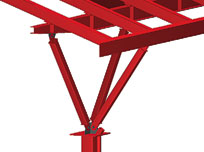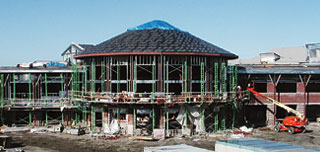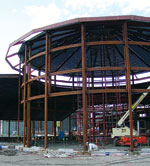 |
Washingtons Tacoma Public School District has become a reluctant pioneer in the slow-but-steady paradigm shift toward computer-aided design and construction, thanks to a convincing argument from the design team to help meet an aggressive construction schedule for a 279,000-sq-ft high school. By allowing the structural engineer to preorder and detail Mt. Tahoma High Schools 1,900 tons of primary steel, taking on risk typically the contractors, TPSD set in motion a chain of events that has sliced at least three months off construction.
The strategy has paid off. The $77.7-million school is on course and budget for substantial completion June 11. "Its working out just as well as we hoped," says Peter J. Wall, TPSDs director of planning and construction.
|
But if integrated steel design (ISD) goes awry, it opens up a pandoras claims box. "If you own the shop drawings" and a piece of steel comes out wrong, "it can affect the whole schedule," says Brandy Matthews-Fox, president of CPM Inc., Seattle, the owners representative.
That is why only extenuating circumstances would prompt TPSD to go down the risky path of ISD again. It did so with Mt. Tahoma because the school is the linchpin of its $450-million capital program. To keep the program on course, the Mt. Tahoma building must be done by August. Then the old Mt. Tahoma building can be vacated and begin its short life as a "swing school" to receive student bodies from the other high schools scheduled for improvements. "It was in the districts best interest to give the Mt. Tahoma project every advantage to be completed in a timely manner," says Wall.
 |
The engineer pushing ISD, Lanny Flynn, vice president of design-build in the Tacoma, Wash., office of project engineer Putnam Collins Scott Associates (PCSA), doesnt agree that it increases the owners exposure. "I feel what we did lowers the owners risk," especially on a public project, says Flynn.
ISD relies on three-dimensional, object-based modeling of the structural steel and reduces the risk of a nonperforming, low-bid detailer, says Flynn. It also results in better-coordinated drawings, fewer fabrication errors and allows foundation work to begin immediately after the contract award, he says.
 |
| BOLD DETAILS Schedule success relied on engineer using 3-D modeling and removing the mill order and steel detailing from the critical path. |
Steel was preordered on Oct. 22, 2002, fabrication began on Feb. 3, 2003, and erection started March 1. Steel was topped out in June. Prompt startup relied on the districts much earlier decision to complete sitework before bidding the general contract. If the site is not ready, ISD is no help, says Matthews-Fox.
There have been only 13 requests for information associated with the structural steel, says Flynn. Four hundred is more typical for a project of this size and complexity. Of 2,908 anchor bolts on the project, which also includes a 3,200-seat stadium, only four for one base plate required modification. There were no mismatched connections, even though they contained 15,256 bolts. In the school building, there were no problems with 3,045 assemblies, reports the team.
 |
Everyone cautions against using ISD frivolously. "There is no reason to go with ISD if you have a normal project," says Jim Burk, senior project manager for the general contractor, Lease Crutcher Lewis, Seattle. He says the approach, which went "tremendously smoothly" in this case, has the potential to fail. One reason is that the detailers drawings go directly out on the fabricators shop floor without being reviewed by the general contractor or steel erector. "If you dont have quality players," says Burk, ISD can "fall on its face."
 |
| STRUCTURE ELEVATED Approach is called challenging because the structural engineer pushes the design process. |
Mt. Tahoma now is 80% finished. Completing it on time hinged on removing the mill order procurement and structural steel detailing from the critical path. A week after the Jan. 8, 2003, award, crews were placing footings. Steel erection began only nine weeks after contract award.
Wall credits much of the success to LCL. "I dont know if another contractor would have been able to respond that quickly" to steel arriving so early, he says. The approach accelerates other elements and procurement, forcing everyone to work harder, he adds.
Calling Mt. Tahoma "a very positive experience," Tom Bates, managing principal of BLRB Architects, Tacoma, says it nevertheless "was challenging" because the structural engineer was pushing the design process.
The arrival of 3-D detailing packages and the ability to link them with design software and computer numerically controlled fabrication equipment provided Flynn with the opportunity to do more than dream of ISDsomething he had been doing long before he arrived at PCSA three years ago. Besides the high school, PCSA has used ISD on a hospital expansion, a high-rise office tower, a medical office building and a jail.
But Flynn cautions that structural engineers should have experience in steel construction and fabrication before they take on ISD. When an engineer leads the detailing, "it is critical" to develop a drawing presentation standard that most fabricators can fabricate off, he says.
"It had a positive spin on the process," says John Farmer, general manager for the steel fabricator, Allied Steel Inc., Lewistown, Mont. There were only 24 misfits of more than 20,000 pieces.
Quality advantages alone do not drive an owner to go with ISD, says Flynn. The approach remains a hard sell for any reason other than schedule advantage.
(Rendering top courtesy of BLRB Architects. All other photos and rendering courtesy of Putnum Collins Scott Associates)
![]() Click below to view more articles related to this story >>
Click below to view more articles related to this story >>
Museum, District Collaborate To Build An Unusual Hybrid
New Jersey Officials Focus on Bringing In New Blood
Demographics Drive Market: Kids Keep School Work Going Strong

Post a comment to this article
Report Abusive Comment